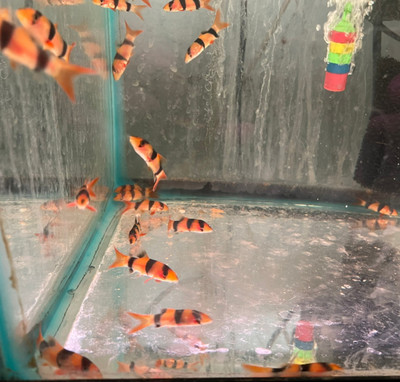The Clown Loach: A Vibrant Addition to the Aquarium
Posted by Max Gandara on on 23rd Apr 2024
The Clown Loach: A Vibrant Addition to the Aquarium
The Clown Loach (Chromobotia macracanthus), with its vibrant colors and playful demeanor, is a popular choice for freshwater aquarium enthusiasts worldwide. Belonging to the Botiidae family, this species is native to the clear waters of Southeast Asia, particularly found in regions like Borneo and Sumatra. Renowned for its striking appearance and engaging behavior, the Clown Loach has captured the hearts of hobbyists for decades.
Physical Characteristics: One of the most striking features of the Clown Loach is its vibrant coloration. Its body is adorned with bright orange-yellow bands alternating with black stripes, resembling a clown's attire, hence its name. Typically, these bands extend from the fish's head to the tip of its tail, creating a visually appealing pattern. The body itself is elongated and laterally compressed, with three pairs of prominent barbels protruding from the mouth, aiding in its sensory perception.
Behavior and Temperament: Clown Loaches are known for their lively and social nature, often seen swimming in groups or pairs. They are naturally curious and will explore their environment with enthusiasm. Additionally, these fish exhibit a fascinating behavior known as "leaning," where they rest on their sides against tank decorations or substrate. This behavior is believed to be a means of communication or a sign of comfort among group members.
Despite their playful demeanor, Clown Loaches can be somewhat shy and sensitive to changes in their environment. Therefore, providing adequate hiding places, such as caves or driftwood, is essential to help them feel secure. Additionally, they thrive in the company of their own kind, so keeping them in groups of at least five individuals is recommended to prevent stress and encourage natural behavior.
Habitat and Tank Requirements: In their natural habitat, Clown Loaches inhabit slow-moving rivers and streams with sandy or muddy substrates, dense vegetation, and submerged tree roots. Replicating these conditions in the aquarium is crucial for their well-being.
A spacious tank with a minimum capacity of 75 gallons is recommended for a group of Clown Loaches, as they can grow quite large, reaching up to 12 inches in length. A sandy substrate mimics their natural environment and allows them to exhibit their digging behavior. Furthermore, ample hiding spots, such as caves, PVC pipes, or hollow logs, should be provided to accommodate their need for shelter and security.
Maintaining stable water parameters is essential for the health of Clown Loaches. They prefer slightly acidic to neutral water with a pH range of 6.5 to 7.5 and a temperature between 75°F to 86°F (24°C to 30°C). Regular water changes and adequate filtration are necessary to keep ammonia and nitrite levels at bay, as these fish are sensitive to poor water quality.
Dietary Needs: Clown Loaches are omnivorous and have a hearty appetite. In their natural habitat, they feed on a varied diet of small crustaceans, insects, plant matter, and detritus. In the aquarium, they readily accept a range of foods, including high-quality sinking pellets, flakes, freeze-dried or frozen bloodworms, brine shrimp, and vegetable matter such as blanched zucchini or cucumber.
Feeding should be done twice daily, offering an amount that the fish can consume within a few minutes to prevent overfeeding and water quality issues. Providing a diverse diet ensures that Clown Loaches receive the necessary nutrients for optimal health and vibrant coloration.
Compatibility: Despite their peaceful nature, Clown Loaches can be territorial towards their own kind, especially if kept in small groups. Therefore, it's crucial to maintain a group of at least five individuals to disperse aggression and prevent bullying within the school. Additionally, they are compatible with a wide range of tank mates, including similarly sized peaceful species like tetras, rasboras, and corydoras catfish. However, caution should be exercised when housing them with smaller fish, as Clown Loaches may view them as potential snacks.
Breeding: While Clown Loaches have been bred in captivity, it remains a challenging endeavor for most hobbyists. Unlike many other freshwater species, they do not readily spawn in the home aquarium, and successful breeding often requires specialized conditions and hormonal induction. As a result, most Clown Loaches available in the aquarium trade are wild-caught specimens.
In conclusion, the Clown Loach is a captivating species that brings color, energy, and personality to any freshwater aquarium. With their vibrant appearance, engaging behavior, and social nature, they have earned a well-deserved place in the hearts of hobbyists around the world. By providing them with a suitable environment, a balanced diet, and the company of their own kind, aquarists can enjoy the beauty and charm of these delightful fish for years to come.

